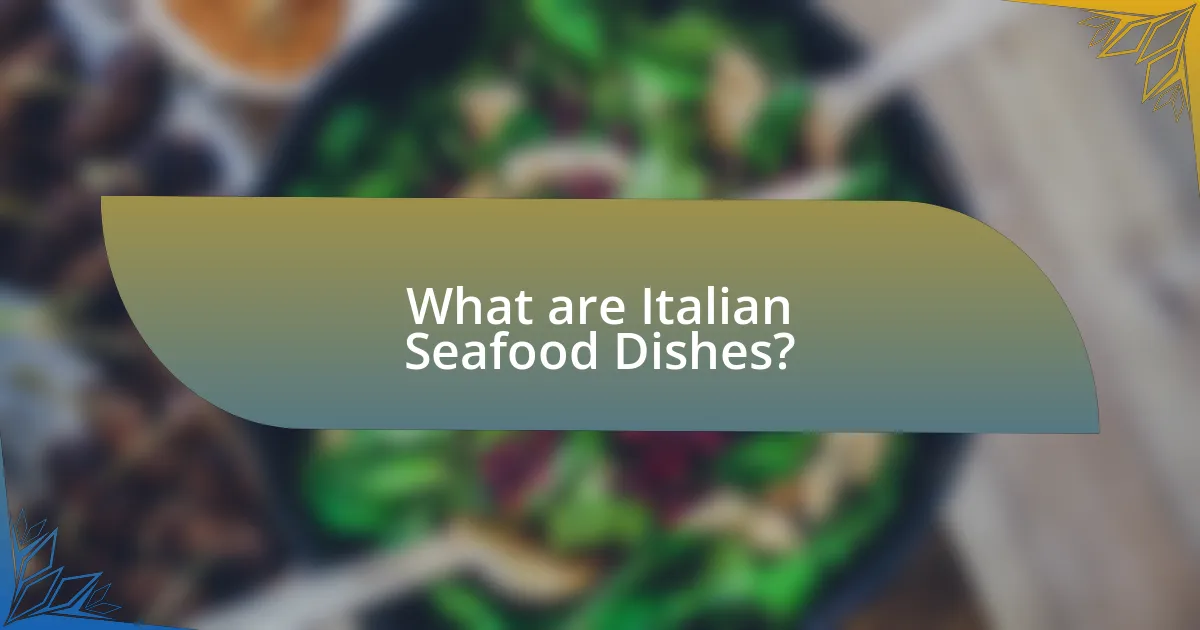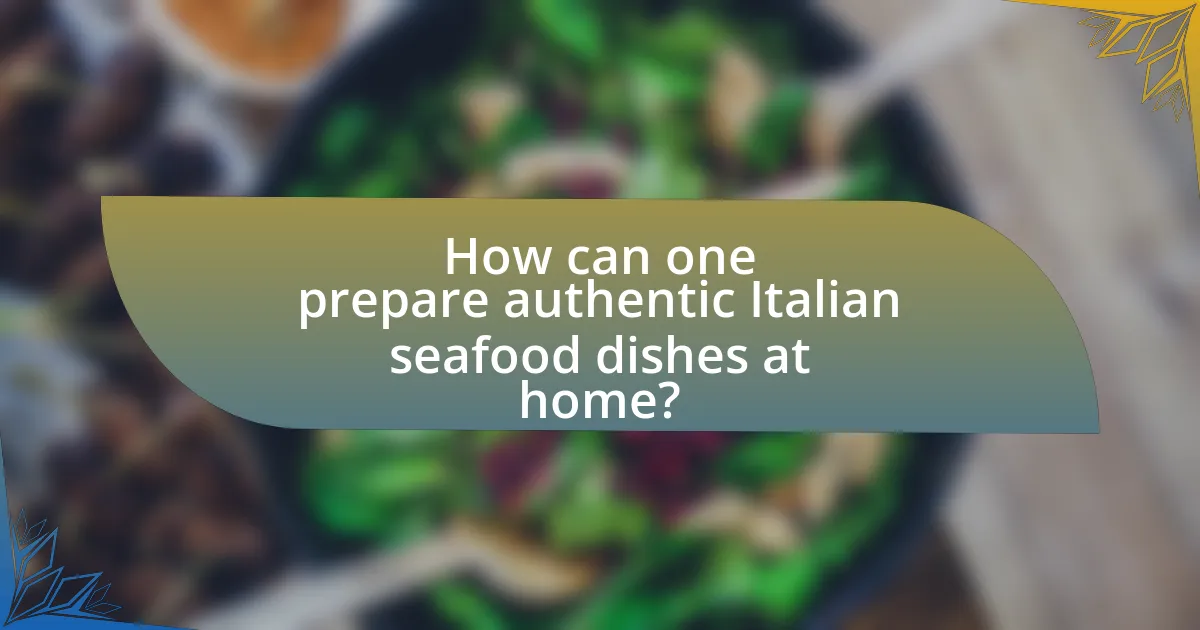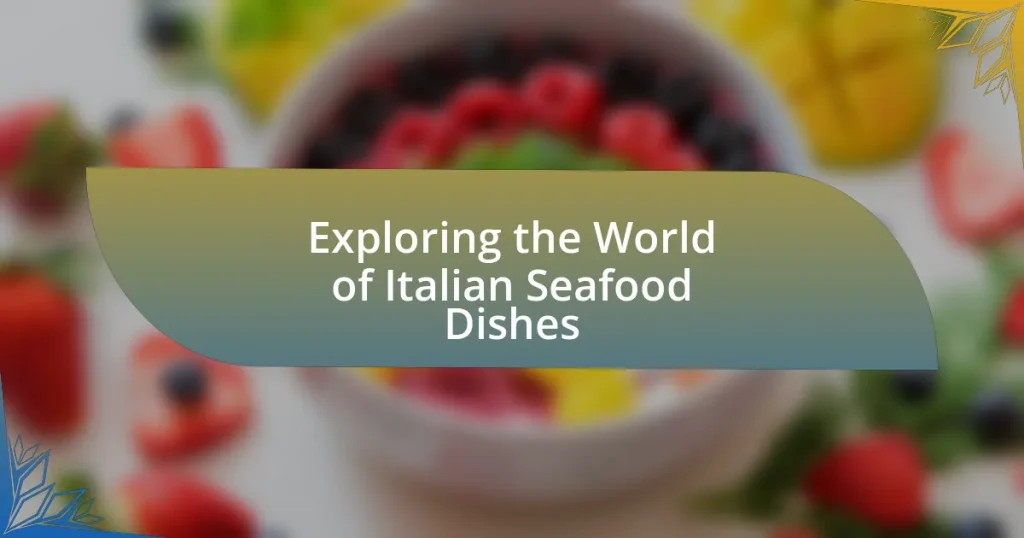Italian seafood dishes are a vital aspect of Italy’s culinary heritage, showcasing fresh fish and shellfish through traditional recipes like spaghetti alle vongole and risotto al nero di seppia. These dishes emphasize high-quality ingredients and simple preparation methods that highlight the natural flavors of the seafood, differing from other cuisines that may rely on heavy sauces. Key ingredients include fresh seafood, olive oil, garlic, and herbs, while preparation techniques such as grilling and poaching preserve the seafood’s delicate texture. Regional variations across Italy, influenced by local traditions and ingredients, further enrich the diversity of Italian seafood cuisine, making it a significant part of the Mediterranean diet and Italian culture.

What are Italian Seafood Dishes?
Italian seafood dishes are culinary creations that prominently feature fish and shellfish, reflecting Italy’s rich maritime heritage. Common examples include spaghetti alle vongole (spaghetti with clams), risotto al nero di seppia (squid ink risotto), and fritto misto (mixed fried seafood). These dishes often highlight fresh, local ingredients and traditional cooking methods, showcasing regional variations across Italy’s coastal areas. The Mediterranean diet, which emphasizes seafood, has been linked to numerous health benefits, further validating the significance of these dishes in Italian cuisine.
How do Italian seafood dishes differ from other cuisines?
Italian seafood dishes differ from other cuisines primarily in their emphasis on fresh, high-quality ingredients and simple preparation methods that highlight the natural flavors of the seafood. Unlike many other culinary traditions that may use heavy sauces or complex spices, Italian seafood often features olive oil, garlic, and fresh herbs, allowing the seafood to be the star of the dish. For example, traditional Italian recipes like spaghetti alle vongole (spaghetti with clams) focus on the freshness of the clams and the simplicity of the preparation, contrasting with cuisines that may incorporate richer sauces or more elaborate cooking techniques. This approach is rooted in Italy’s coastal geography and culinary philosophy, which values seasonal and local produce, making Italian seafood dishes distinct in their flavor profiles and presentation.
What are the key ingredients in Italian seafood dishes?
Key ingredients in Italian seafood dishes include fresh fish, shellfish, olive oil, garlic, tomatoes, and herbs such as parsley and basil. Fresh fish, such as branzino and sardines, is often the centerpiece, while shellfish like clams, mussels, and shrimp add variety and flavor. Olive oil serves as a primary cooking fat, enhancing the dish’s richness. Garlic and tomatoes contribute essential aromatics and acidity, balancing the flavors. Herbs like parsley and basil provide freshness and depth, commonly used in traditional recipes like spaghetti alle vongole and risotto ai frutti di mare.
How is the preparation of seafood unique in Italian cooking?
The preparation of seafood in Italian cooking is unique due to its emphasis on fresh, high-quality ingredients and simple techniques that enhance the natural flavors of the seafood. Italian cuisine often utilizes methods such as grilling, poaching, and sautéing, which preserve the delicate texture and taste of the seafood. For instance, dishes like “spaghetti alle vongole” (spaghetti with clams) highlight the use of fresh clams, garlic, and olive oil, allowing the seafood to shine without overwhelming it with heavy sauces. This approach is rooted in Italy’s coastal geography, where access to fresh seafood is abundant, and reflects a culinary philosophy that prioritizes seasonal and local produce.
Why is seafood important in Italian culture?
Seafood is important in Italian culture due to its historical significance and regional culinary practices. Coastal regions of Italy, such as Sicily and Liguria, have relied on seafood as a primary food source for centuries, shaping local diets and traditions. The Mediterranean Sea provides a rich variety of fish and shellfish, which are integral to traditional dishes like spaghetti alle vongole and fritto misto. Additionally, seafood is often associated with religious practices, particularly during Lent, when many Italians abstain from meat and consume fish instead. This cultural emphasis on seafood reflects Italy’s deep connection to the sea and its influence on Italian gastronomy.
What regions in Italy are known for their seafood dishes?
The regions in Italy known for their seafood dishes include Liguria, Campania, Sicily, and Calabria. Liguria, with its coastal location, is famous for dishes like pesto alla genovese and seafood pasta. Campania, particularly around Naples, is renowned for its fresh fish and the iconic dish spaghetti alle vongole. Sicily boasts a rich seafood tradition, featuring dishes such as sarde a beccafico and couscous di pesce. Calabria, with its access to the Tyrrhenian and Ionian Seas, offers specialties like ‘nduja and various fish stews. These regions leverage their coastal geography to create diverse and flavorful seafood cuisines.
How do local traditions influence seafood recipes in Italy?
Local traditions significantly influence seafood recipes in Italy by incorporating regional ingredients, cooking techniques, and cultural practices. For instance, coastal areas like Sicily emphasize fresh catch, using local fish such as swordfish and sardines, often prepared with simple ingredients like olive oil, garlic, and herbs to highlight the seafood’s natural flavors. Additionally, festivals such as the Feast of San Giovanni in Naples showcase traditional dishes like spaghetti alle vongole, which reflect local customs and seasonal availability of clams. This connection between local traditions and seafood recipes not only preserves culinary heritage but also fosters a sense of community and identity among the regions.

What are the most popular Italian seafood dishes?
The most popular Italian seafood dishes include spaghetti alle vongole, risotto al nero di seppia, and fritto misto. Spaghetti alle vongole features pasta with clams, garlic, and olive oil, showcasing the coastal flavors of Italy. Risotto al nero di seppia is a creamy rice dish made with cuttlefish ink, providing a distinct black color and rich taste. Fritto misto consists of a variety of fried seafood, often served as an appetizer, highlighting the freshness of the catch. These dishes are celebrated for their regional ingredients and traditional preparation methods, making them staples in Italian cuisine.
What are the signature seafood dishes of Italy?
The signature seafood dishes of Italy include Spaghetti alle Vongole, Fritto Misto, and Risotto al Nero di Seppia. Spaghetti alle Vongole features pasta with clams, garlic, and olive oil, originating from coastal regions like Campania. Fritto Misto is a mixed fried seafood dish, popular in various regions, showcasing the freshness of local catches. Risotto al Nero di Seppia is a risotto made with cuttlefish ink, primarily found in Venetian cuisine, highlighting the use of seafood in traditional Italian cooking. These dishes exemplify Italy’s rich maritime culinary heritage.
How is Spaghetti alle Vongole prepared?
Spaghetti alle Vongole is prepared by cooking spaghetti until al dente, then sautéing garlic in olive oil, adding fresh clams, and deglazing with white wine. The clams are cooked until they open, and the pasta is combined with the clam sauce, garnished with parsley. This method highlights the dish’s simplicity and reliance on fresh ingredients, which is a hallmark of Italian cuisine.
What makes Fritto Misto a beloved dish?
Fritto Misto is a beloved dish primarily due to its delightful combination of fresh seafood and vegetables, which are lightly battered and fried to achieve a crispy texture. This dish showcases the quality and variety of ingredients, often including shrimp, calamari, and seasonal vegetables, making it a versatile option that appeals to many palates. The harmonious blend of flavors and textures, along with its presentation, enhances the dining experience, contributing to its popularity in Italian cuisine. Additionally, Fritto Misto is often enjoyed as a communal dish, fostering a sense of sharing and enjoyment among diners, which further solidifies its status as a cherished culinary choice.
What variations exist within Italian seafood dishes?
Italian seafood dishes exhibit a wide range of variations influenced by regional ingredients, cooking techniques, and cultural traditions. For example, in coastal regions like Liguria, dishes often feature fresh fish and herbs, while in Sicily, seafood is commonly combined with sweet and sour flavors, such as in the dish “sarde a beccafico,” which includes sardines stuffed with breadcrumbs, raisins, and pine nuts. Additionally, the preparation methods vary; some regions favor grilling or frying, while others may use stewing or baking techniques. The diversity of Italian seafood dishes is further enriched by local specialties, such as “spaghetti alle vongole” from Naples, which highlights clams, and “fritto misto” from the Adriatic, showcasing a mix of fried seafood. This regional variation reflects Italy’s extensive coastline and rich maritime culture, resulting in a vibrant culinary landscape.
How do different regions put their spin on classic seafood recipes?
Different regions in Italy put their spin on classic seafood recipes by incorporating local ingredients, traditional cooking methods, and unique flavor profiles. For example, the coastal regions of Liguria emphasize the use of fresh basil and olive oil in dishes like pesto alla genovese, which is often paired with seafood such as trofie pasta and mussels. In contrast, the Sicilian approach includes sweet and sour flavors, evident in dishes like sardines alla beccafico, where raisins and pine nuts are combined with fish. Additionally, the Neapolitan style showcases the use of tomatoes and garlic in seafood pasta dishes, such as spaghetti alle vongole, highlighting the region’s rich agricultural produce. These regional adaptations reflect the diverse culinary heritage of Italy, showcasing how local resources and traditions shape seafood cuisine.
What are some lesser-known Italian seafood dishes worth trying?
Some lesser-known Italian seafood dishes worth trying include “Cacciucco,” a Tuscan fish stew made with various types of fish and shellfish, and “Sgombro alla Griglia,” which features grilled mackerel often seasoned with herbs and lemon. Additionally, “Baccalà Mantecato,” a Venetian dish of whipped salt cod, and “Frittura di Paranza,” a mixed fry of small fish and seafood, are also noteworthy. These dishes reflect regional culinary traditions and utilize local seafood, showcasing Italy’s diverse maritime heritage.

How can one prepare authentic Italian seafood dishes at home?
To prepare authentic Italian seafood dishes at home, one should focus on using fresh, high-quality seafood and traditional Italian cooking techniques. Start by selecting ingredients such as fresh fish, shellfish, and seasonal vegetables, which are essential for authenticity. Techniques like sautéing, grilling, and poaching are commonly used in Italian seafood recipes, emphasizing simplicity and the natural flavors of the ingredients. For example, a classic dish like Spaghetti alle Vongole requires fresh clams, garlic, olive oil, and parsley, showcasing the importance of quality and technique in Italian cuisine. This approach aligns with the Italian culinary philosophy of using minimal ingredients to highlight the seafood’s freshness and flavor.
What essential techniques should be learned for cooking seafood?
Essential techniques for cooking seafood include proper cleaning, seasoning, cooking methods, and timing. Cleaning seafood involves removing scales, shells, and entrails to ensure freshness and safety. Seasoning enhances flavor; common seasonings include salt, pepper, lemon, and herbs like parsley or basil, which are often used in Italian cuisine. Cooking methods such as grilling, poaching, sautéing, and baking are crucial, as they affect texture and taste. Timing is critical; overcooking seafood can lead to a rubbery texture, while undercooking can pose health risks. Mastering these techniques is essential for creating authentic Italian seafood dishes, as they ensure the seafood is flavorful and safe to eat.
How do you properly clean and prepare seafood for cooking?
To properly clean and prepare seafood for cooking, start by rinsing the seafood under cold running water to remove any surface debris or contaminants. For shellfish, such as clams and mussels, soak them in cold water for about 20 minutes to allow them to expel sand and grit. After soaking, scrub the shells with a brush to ensure they are clean. For fish, remove the scales using a scaler or the back of a knife, and gut the fish by making a cut along the belly and removing the innards. Rinse the fish again after gutting. Proper cleaning is essential to eliminate harmful bacteria and ensure the seafood is safe for consumption. According to the USDA, seafood should be handled with care to prevent foodborne illnesses, emphasizing the importance of cleanliness in seafood preparation.
What cooking methods are most effective for seafood?
The most effective cooking methods for seafood include steaming, grilling, poaching, and baking. Steaming preserves moisture and nutrients, making it ideal for delicate fish like sole or flounder. Grilling imparts a smoky flavor and is suitable for firmer fish such as salmon or swordfish. Poaching, often done in broth or wine, gently cooks seafood while enhancing its flavor, making it perfect for shrimp or scallops. Baking allows for even cooking and is versatile for various seafood types, including whole fish or fillets. These methods are widely recognized for their ability to maintain the seafood’s natural flavors and textures.
What ingredients are essential for authentic Italian seafood dishes?
Essential ingredients for authentic Italian seafood dishes include fresh seafood such as fish, shellfish, and crustaceans, along with high-quality olive oil, garlic, fresh herbs like parsley and basil, tomatoes, and white wine. These ingredients are fundamental because they reflect the coastal regions of Italy, where seafood is a staple. The use of fresh, local ingredients is crucial in Italian cuisine, as it enhances the flavor and authenticity of the dishes. For example, the Mediterranean Sea provides a variety of fish and shellfish that are integral to traditional recipes, while olive oil is a key component in cooking and dressing seafood dishes.
Where can you find the best seafood for Italian recipes?
The best seafood for Italian recipes can be found at local fish markets, particularly those that specialize in fresh, sustainable seafood. These markets often source their products from nearby coastal areas, ensuring high quality and freshness. For example, the Fulton Fish Market in New York City is renowned for its wide selection of seafood, including clams, mussels, and various fish species commonly used in Italian cuisine. Additionally, coastal regions in Italy, such as Sicily and Liguria, are known for their exceptional seafood, often featured in traditional Italian dishes.
What pantry staples complement Italian seafood dishes?
Olive oil, garlic, capers, and fresh herbs are essential pantry staples that complement Italian seafood dishes. Olive oil serves as a base for cooking and enhances flavor, while garlic adds depth and aroma. Capers provide a briny contrast that pairs well with various seafood, and fresh herbs like parsley and basil contribute brightness and freshness to the dishes. These ingredients are commonly used in traditional Italian recipes, reinforcing their importance in enhancing the overall taste and authenticity of seafood preparations.
What tips can enhance the preparation of Italian seafood dishes?
To enhance the preparation of Italian seafood dishes, prioritize the use of fresh, high-quality ingredients, as they significantly impact flavor and texture. Fresh seafood, such as fish, shellfish, and crustaceans, should be sourced from reputable suppliers to ensure optimal taste and safety. Additionally, incorporating traditional Italian herbs and spices, like parsley, basil, and garlic, can elevate the dish’s flavor profile. Cooking techniques, such as grilling, sautéing, or steaming, should be employed to preserve the seafood’s natural flavors while avoiding overcooking, which can lead to a rubbery texture. Finally, pairing seafood with complementary ingredients, such as citrus, tomatoes, or olive oil, enhances the overall dish and aligns with authentic Italian culinary practices.
How can you ensure freshness in seafood dishes?
To ensure freshness in seafood dishes, purchase seafood from reputable suppliers who adhere to strict quality standards. Fresh seafood should have a clean, ocean-like smell, firm texture, and bright, clear eyes if whole. According to the FDA, seafood should be kept at temperatures below 40°F to prevent spoilage, and it is advisable to consume it within 1-2 days of purchase for optimal freshness.
What common mistakes should be avoided when cooking seafood?
Common mistakes to avoid when cooking seafood include overcooking, which can lead to a rubbery texture, and not properly cleaning the seafood, resulting in off-flavors. Overcooking seafood is a frequent error; for example, shrimp should be cooked until just opaque, typically 2-3 minutes, to maintain tenderness. Additionally, failing to remove shells, veins, or other inedible parts can compromise the dish’s quality. Properly sourcing fresh seafood is also crucial, as using previously frozen or low-quality seafood can affect flavor and texture. According to the USDA, seafood should be cooked to an internal temperature of 145°F to ensure safety and optimal taste.















